
Hemaris gracilis, the slender clearwing or graceful clearwing, is a moth of the family Sphingidae. The species was first described by Augustus Radcliffe Grote and Coleman Townsend Robinson in 1865.

Drasteria is a genus of moths in the family Erebidae.

Catocala badia, the bay underwing, bayberry underwing or old maid, is a moth of the family Erebidae. It is found from southern Maine and New Hampshire south to New York and Connecticut.

Catocala pretiosa, the precious underwing, is a moth of the family Erebidae. The species was first described by Joseph Albert Lintner in 1876. It was included in Catocala crataegi by many authors, but recently it has been revalidated as a distinct species. The subspecies of pretiosa is listed as a species of special concern and believed extirpated in the US state of Connecticut.

Catocala herodias, the Herodias underwing or Gerhard's underwing, is a moth of the family Erebidae. The species was first described by Strecker in 1876. The nominate form is found in the US states of Texas and Oklahoma. Subspecies Catocala herodias gerhardi is found from Massachusetts, Connecticut, New York to Virginia. The gerhardi subspecies is listed as endangered in Connecticut.

Drasteria adumbrata, the shadowy arches, is a moth of the family Erebidae. The species was first described by Hans Hermann Behr in 1870. It is found from coast to coast in southern Canada, south in the west to California and Colorado, south in the east to New England and Michigan. Subspecies D. a. alleni is found from eastern Alberta to New York and Nova Scotia. Subspecies D. a. saxea occurs from southern British Columbia and south-west Alberta south to California and Colorado.
Drasteria hudsonica, the northern arches, is a moth of the family Erebidae. The species was first described by Augustus Radcliffe Grote and Coleman Townsend Robinson in 1865. It is found from Alaska and Yukon to California, east to New Mexico and Manitoba.
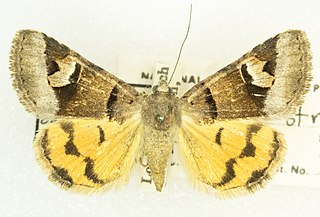
Drasteria perplexa, the perplexing or perplexed arches, is a moth of the family Erebidae. The species was first described by Henry Edwards in 1884. It is found in North America from Alberta and Saskatchewan south to Colorado and Arizona.
Drasteria petricola, the little arches, is a moth of the family Erebidae. The species was first described by Francis Walker in 1858. It is found in western North America from Yukon and the Northwest Territories south to New Mexico in the Rocky Mountains, east to Manitoba.

Drasteria grandirena, the figure-seven moth or great kidney, is a moth of the family Erebidae first described by Adrian Hardy Haworth in 1809. It is found in North America from Ontario, Quebec and Nova Scotia, south to at least Georgia west to at least Arkansas

Drasteria howlandii is a moth of the family Erebidae. It is found from British Columbia and Saskatchewan south through the western parts of the United States from Washington south to Arizona and Texas.

Drasteria sabulosa is a moth of the family Erebidae. It is found from British Columbia south into the United States where it found as far east as Wyoming, Utah, Colorado, New Mexico and as far south as Arizona.
Drasteria mirifica is a moth of the family Erebidae. It is found in North America, including Nevada, Oregon and California.
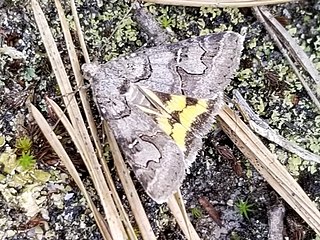
Drasteria graphica, the graphic moth, is a moth of the family Erebidae. The species was first described by Jacob Hübner in 1818. It is found in the United States in coastal dunes from Maine to Florida, west to Mississippi. It is also found along the shores of the Great Lakes in Michigan and Wisconsin. Subspecies D. g. atlantica is listed as threatened in Connecticut.
Drasteria inepta, the inept drasteria, is a moth of the family Erebidae. It is found from Arizona to Texas, north to Colorado and Utah.
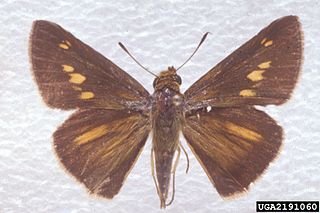
Euphyes dion, the Dion skipper or Alabama skipper, is a species of butterfly of the family Hesperiidae. It is found in scattered populations along the Atlantic coast of North America, from western Massachusetts and south-eastern New York south to north-eastern Florida, west to north-eastern Texas, and north to south-eastern North Dakota, northern Wisconsin, southern Ontario and southern Quebec. It is listed as a species of special concern in the US state of Connecticut.

Drasteria caucasica is a moth of the family Erebidae. It is found in Romania, north-eastern Bulgaria, southern Moldova, southern Ukraine, Russia, Kazakhstan, Turkey, Daghestan, Armenia, Iraq, Iran, Turkmenistan, Uzbekistan, Tajikistan, Afghanistan, Pakistan, Kyrghyzstan, China and Mongolia.
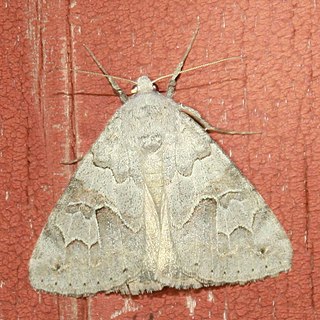
Drasteria scrupulosa is a moth of the family Erebidae. It is found in North America, where it has been recorded from California, Idaho, Nevada, Oregon and Utah. The habitat consists of open sagebrush steppes.
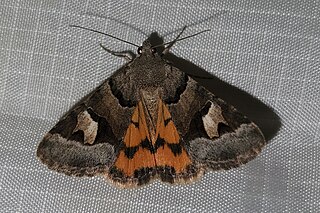
Drasteria stretchii is a species of moth in the family Erebidae. It is found in North America, where it has been recorded from northern Nevada., California, Oregon, Wyoming and Washington. The habitat consists of dry, rocky canyons at low to middle elevations.

Glena cognataria, the blueberry gray moth, is a moth native to North America. It ranges from Florida to Nova Scotia and New Brunswick. Its larvae is hosted on blueberry. The habitat consists of bogs and pine barrens. It is listed as a species of special concern and believed extirpated in the US state of Connecticut.














